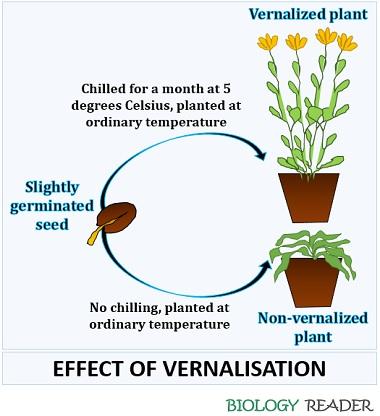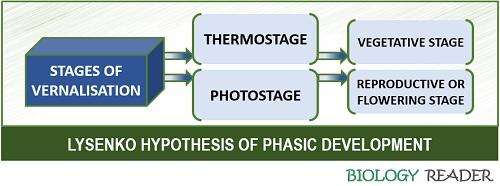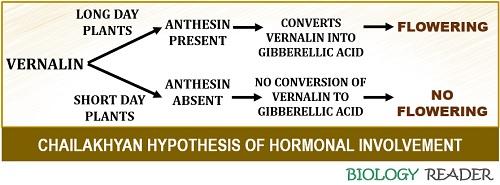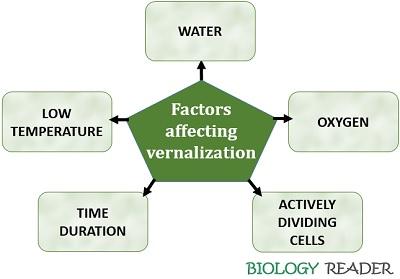Vernalization refers to the process of growing flowers and fruits through a phase of cold treatment. It reduces the time period of the juvenile vegetative growth phase in the plants. The active meristematic cells of the shoot apex, root apex, embryo tips etc., participate in the production of stimulus (Vernalin).
The term vernalization has been originated from the Latin word Vernalis, i.e. “of the spring”. Before plant reproduction, it allows vegetative maturity. The process of vernalization is significantly employed in food plants (wheat, barley, rye etc.), biennial plants (cabbage, sugar beet etc.) and perennial plants (like chrysanthemum).
In this context, we will study the definition, discoveries that led to the theory of vernalization. You will also get to know the primary factors affecting the vernalization technique, along with its mechanism and importance.
Content: Vernalization
Definition of Vernalization
Vernalization refers to the process in which the seedling is subjected to low temperature (5-10 degrees Celsius) during winter, and by the development of flowers and fruits, the seedling is exposed to a high temperature (about 40 degrees Celsius).
Therefore, it merely refers to the process of going dormant in the cold temperature. The process of subjecting seedlings from the cold temperature to the high temperature is called devernalization. The temperature and the time period of the chilling process depend upon the plant species.

A plant depends (both qualitatively and quantitatively) upon exposure to the cold temperature to develop reproductive structures like flowers and fruits. The temperature has a major effect on germination, growth and metabolic activities.
The plants must need exposure to cold treatment for germination and flowering in plants, whether they grow at a high or low temperature. Vernalization occurs in two ways, namely facultative and obligate.
- Facultative vernalization results in early flowering once the seedling is subjected to a low temperature.
- Obligate vernalization requires exposure of the seedling to the desired time period to induce flowering.
History
Many contributors gave their different theories and approaches to describe the phenomena of vernalization.
| Year | Discoverer | Discovery |
|---|---|---|
| 1857 | John Hancock Klippart | Demonstrated the effect of winter temperature on germination |
| 1918 | Gustav Gassner | Published an article to differentiate specific requirements of winter from the summer plants |
| 1928 | Lysenko | Introduced the chilling process on cereal seeds and given the term vernalization |
| 1960 | Chourad | Defined vernalization as a process of accelerating flowering in plants by the chilling treatment |
Mechanism of Vernalization
It involves the following steps:

- Seed moistening: First, soak the seeds in water and later allow them to germinate in the processing chamber under 10-12 degrees Celsius.
- Chilling treatment: Expose the germinated seeds to the low temperature (3-5 degrees Celsius) upto desired time.
- Drying and sowing: Seeds are then dried and sown in a field with adequate water and oxygen supply.
There are two hypotheses, which explain the theory of vernalization.
The hypothesis of phasic development
According to Lysenko, the vernalization method completes in two stages:

- Thermostage: It refers to the primary stage, where the slightly germinated seeds are exposed to a low temperature of 0-5 degrees Celsius in the presence of oxygen and moisture. During this stage, structures like root, stem, and leaves develop, known as the vegetative phase. Here, the seed loses its dormancy and starts to germinate.
- Photostage: It is the secondary stage when the seedlings are subjected to the phase of correct photoperiod or high temperature upto 40 degrees Celsius. It refers to the reproductive stage, where the seedlings grow the reproductive structures like flowers and fruits.
The hypothesis of hormonal involvement
According to Chailakhyan, the vernalization method has two possibilities:

- In long-day plants: A flowering hormone anthesin in long-day plants converts vernalin hormone into a growth-regulating hormone gibberellic acid, which finally induces flowering in plants.
- In short-day plants: They lack a flowering hormone anthesin, which converts vernalin into gibberellic acid, thereby inducing no flowering.
Examples of Vernalizatized Plants
- Food plants (wheat, rye, etc.) have both spring and winter varieties. The spring and winter varieties are sown in the spring season and autumn season, respectively.
- Biennial plants (carrot, sugar beet, etc.) take two years to flower. In the first year, a plant undergoes vegetative growth, while in the second year, it becomes dormant during the winter, thereby producing flowers and fruits, and finally dies in the next summer.
Factors Affecting
The factors affecting vernalization includes:

- Low temperature: A general process to grow healthy plants by employing vernalization technique primarily requires a low temperature ranging between 0-10 degrees Celsius. After this, you need to subject the seedlings to a high temperature of 40 degrees Celsius.
- Time period: The time period of vernalization depends upon the plant type, and it can vary from a few days to weeks or even several months.
- Actively dividing cells: The process of vernalization occurs in the germinating seeds, which comprises an active embryo. Thus, the process does not occur in the dry seeds. It requires seeds moistened with active meristematic cells.
- Water and Oxygen: Proper protoplasmic hydration is a prerequisite for the seedling to recognize a stimulus. Vernalization needs adequate oxygen, as it is an aerobic process that regulates the metabolic energy inside plant cells.
Importance
- Vernalization gives adequate time for the plants to get mature and also prevents pre-maturing during their growing season.
- It reduces the vegetative phase and hastens the reproductive period.
- Vernalization increases the plant’s growth and yield.
- Vernalization makes the plants more adaptable by allowing them to grow in regions where they usually don’t grow.
- It also removes wrinkles on the kernels of the Triticale.
- It is not only applicable for growing temperate plants, but also some tropical plants like wheat, rice, millets etc.
Conclusion
Therefore, we can conclude that vernalization is a method of inciting early flowering in plants by the pretreatment of seeds under a low temperature. Reversal of the vernalization process is an effect known as devernalization, which interrupts the process during the period of low temperature into a high temperature.
“Drying and sowing: Seeds are then dried and sown in a field at proper water and oxygen supply”.
Please could you explain the extent of drying the seeds as referred to above? It is not very clear to me how and why the drying is done.
Thank you